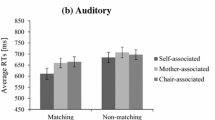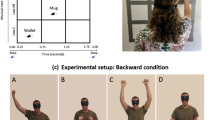Abstract
Shape is an inherent property of objects existing in both vision and touch but not audition. Can shape then be represented by sound artificially? It has previously been shown that sound can convey visual information by means of image-to-sound coding, but whether sound can code tactile information is not clear. Blindfolded sighted individuals were trained to recognize tactile spatial information using sounds mapped from abstract shapes. After training, subjects were able to match auditory input to tactually discerned shapes and showed generalization to novel auditory–tactile pairings. Furthermore, they showed complete transfer to novel visual shapes, despite the fact that training did not involve any visual exposure. In addition, we found enhanced tactile acuity specific to the training stimuli. The present study demonstrates that as long as tactile space is coded in a systematic way, shape can be conveyed via a medium that is not spatial, suggesting a metamodal representation.




Similar content being viewed by others
References
Ahissar M, Hochstein S (1993) Attentional control of early perceptual learning. Proc Natl Acad Sci USA 90:5718–5722
Amedi A, Malach R, Hendler T, Peled S, Zohary E (2001) Visuo-haptic object-related activation in the ventral visual pathway. Nat Neurosci 4:324–330
Amedi A, von Kriegstein K, van Atteveldt NM, Beauchamp MS, Naumer MJ (2005) Functional imaging of human crossmodal identification and object recognition. Exp Brain Res 166:559–571
Amedi A, Stern WM, Camprodon JA, Bermpohl F, Merabet L, Rotman S, Hemond C, Meijer P, Pascual-Leone A (2007) Shape conveyed by visual-to-auditory sensory substitution activates the lateral occipital complex. Nat Neurosci 10:687–689
Arno P, Capelle C, Wanet-Defalque MC, Catalan-Ahumada M, Veraart C (1999) Auditory coding of visual patterns for the blind. Perception 28:1013–1029
Auvray M, Hanneton S, O’Regan JK (2007) Learning to perceive with a visuo-auditory substitution system: localisation and object recognition with ‘the vOICe’. Perception 36:416–430
Bach-y-Rita P (1972) Brain mechanisms in sensory substitution. Academic Press, London
Bach-y-Rita P, Collins CC, Saunders FA, White B, Scadden L (1969) Vision substitution by tactile image projection. Nature 221:963–964
Ball K, Sekuler R (1987) Direction-specific improvement in motion discrimination. Vision Res 27:953–965
Calvert GA (2001) Crossmodal processing in the human brain: insights from functional neuroimaging studies. Cereb Cortex 11:1110–1123
Capelle C, Trullemans C, Arno P, Veraart C (1998) A real-time experimental prototype for enhancement of vision rehabilitation using auditory substitution. IEEE Trans Biomed Eng 45:1279–1293
Carello C, Anderson KL, Kunkler-Peck AJ (1998) Perception of object length by sound. Psychol Sci 9:211–214
Crist RE, Kapadia MK, Westheimer G, Gilbert CD (1997) Perceptual learning of spatial localization: specificity for orientation, position, and context. J Neurophysiol 78:2889–2894
Crist RE, Li W, Gilbert CD (2001) Learning to see: experience and attention in primary visual cortex. Nat Neurosci 4:519–525
Deibert E, Kraut M, Kremen S, Hart J Jr (1999) Neural pathways in tactile object recognition. Neurology 52:1413–1417
Fiorentini A, Berardi N (1980) Perceptual learning specific for orientation and spatial frequency. Nature 287:43–44
Gibson JJ (1966) The senses considered as perceptual systems. Houghton Mifflin, Boston
Grassi M (2005) Do we hear size or sound? Balls dropped on plates. Percept Psychophys 67:274–284
Irvine DR, Martin RL, Klimkeit E, Smith R (2000) Specificity of perceptual learning in a frequency discrimination task. J Acoust Soc Am 108:2964–2968
James TW, Humphrey GK, Gati JS, Servos P, Menon RS, Goodale MA (2002) Haptic study of three-dimensional objects activates extrastriate visual areas. Neuropsychologia 40:1706–1714
Kim JK, Zatorre RJ (2008) Generalized learning of visual-to-auditory substitution in sighted individuals. Brain Res 1242:263–275
Kunkler-Peck AJ, Turvey MT (2000) Hearing shape. J Exp Psychol Hum Percept Perform 26:279–294
Li W, Piech V, Gilbert CD (2004) Perceptual learning and top-down influences in primary visual cortex. Nat Neurosci 7:651–657
Meijer PB (1992) An experimental system for auditory image representations. IEEE Trans Biomed Eng 39:112–121
Meinhardt G (2002) Learning to discriminate simple sinusoidal gratings is task specific. Psychol Res 66:143–156
Mesulam MM (1998) From sensation to cognition. Brain 121:1013–1052
Norman JF, Norman HF, Clayton AM, Lianekhammy J, Zielke G (2004) The visual and haptic perception of natural object shape. Percept Psychophys 66:342–351
Norman JF, Clayton AM, Norman HF, Crabtree CE (2008) Learning to perceive differences in solid shape through vision and touch. Perception 37:185–196
Pascual-Leone A, Hamilton R (2001) The metamodal organization of the brain. Prog Brain Res 134:427–445
Polley DB, Steinberg EE, Merzenich MM (2006) Perceptual learning directs auditory cortical map reorganization through top-down influences. J Neurosci 26:4970–4982
Reales JM, Ballesteros S (1999) Implicit and explicit memory for visual and haptic objects: cross-modal priming depends on structural descriptions. J Exp Psychol Learn Mem Cogn 25:644–663
Recanzone GH, Merzenich MM, Jenkins WM, Grajski KA, Dinse HR (1992) Topographic reorganization of the hand representation in cortical area 3b owl monkeys trained in a frequency-discrimination task. J Neurophysiol 67:1031–1056
Recanzone GH, Schreiner CE, Merzenich MM (1993) Plasticity in the frequency representation of primary auditory cortex following discrimination training in adult owl monkeys. J Neurosci 13:87–103
Renier L, Collignon O, Poirier C, Tranduy D, Vanlierde A, Bol A, Veraart C, De Volder AG (2005a) Cross-modal activation of visual cortex during depth perception using auditory substitution of vision. Neuroimage 26:573–580
Renier L, Laloyaux C, Collignon O, Tranduy D, Vanlierde A, Bruyer R, De Volder AG (2005b) The Ponzo illusion with auditory substitution of vision in sighted and early-blind subjects. Perception 34:857–867
Sathian K, Zangaladze A, Hoffman JM, Grafton ST (1997) Feeling with the mind’s eye. Neuroreport 8:3877–3881
Teich AF, Qian N (2003) Learning and adaptation in a recurrent model of V1 orientation selectivity. J Neurophysiol 89:2086–2100
Van Boven RW, Johnson KO (1994) The limit of tactile spatial resolution in humans: grating orientation discrimination at the lip, tongue, and finger. Neurology 44:2361–2366
Zangaladze A, Epstein CM, Grafton ST, Sathian K (1999) Involvement of visual cortex in tactile discrimination of orientation. Nature 401:587–590
Acknowledgments
We thank Dr. Peter Meijer for his helpful discussions, Nick Foster and Patrick Bermudez for their technical assistance and Jana Levene for her stimuli preparation. This research was supported by grants from the Canadian Institutes of Health Research and the Natural Sciences and Engineering Research Council of Canada.
Author information
Authors and Affiliations
Corresponding author
Rights and permissions
About this article
Cite this article
Kim, JK., Zatorre, R.J. Can you hear shapes you touch?. Exp Brain Res 202, 747–754 (2010). https://doi.org/10.1007/s00221-010-2178-6
Received:
Accepted:
Published:
Issue Date:
DOI: https://doi.org/10.1007/s00221-010-2178-6




